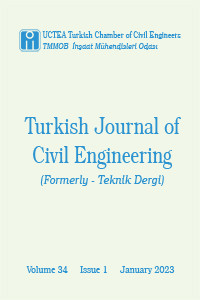Kentiçi Toplu Taşıma Sistemlerinde Performansa Dayalı Ödeme Modelinin Geliştirilmesi
Performansa Dayalı Sözleşme, ANFIS, Özel Toplu Taşıma Ödeme Modeli, Anahtar Performans Göstergeleri, AHP
Developing a Performance-Based Payment Model in Urban Public Transport Systems
Performance Based Contract, ANFIS, Public Transportation Payment Model, Key Performance Indicators, AHP,
___
- J. Pucher, A. Markstedt, ve I. Hirschman, “Impacts of subsidies on the costs of urban public transport ( USA).”, Journal of Transport Economics & Policy, c. 17, sayı 2, ss. 155–176, 1983.
- P. Tisato, “A comparison of optimisation formulations in public transport subsi dy”, International Journal of Transport Economics, 2000.
- K. A. Small ve E. T. Verhoef, The economics of urban transportation. 2007.
- I. W. H. Parry ve K. A. Small, “Should urban transit subsidies be reduced?”, American Economic Review, 2009, doi: 10.1257/aer.99.3.700.
- J. Mattson ve D. Ripplinger, “Marginal cost pricing and subsidy of small urban transit”, Transportation Research Record, 2012, doi: 10.3141/2274-08.
- A. Mouwen ve J. Van Ommeren, “The effect of contract renewal and competitive tendering on public transport costs, subsidies and ridership”, Transportation Research Part A: Policy and Practice, 2016, doi: 10.1016/j.tra.2016.03.003.
- M. Ševrović, D. Brčić, ve G. Kos, “Transportation Costs and Subsidy Distribution Model for Urban and Suburban Public Passenger Transport”, PROMET - Traffic&Transportation, 2015, doi: 10.7307/ptt.v27i1.1486.
- A. Gautier ve A. Yvrande-Billon, “Contract Renewal as an Incentive Device. An Application to the French Urban Public Transport Sector”, Review of Economics and Institutions, 2013, doi: 10.5202/rei.v4i1.88.
- D. A. Hensher, C. Mulley, ve N. Smith, “Towards a simplified performance-linked value for money model as a reference point for bus contract payments”, Research in Transportation Economics, 2013, doi: 10.1016/j.retrec.2012.06.018.
- F. Canıtez, D. Çelebi, M. Deveci, ve Y. Kuvvetli, “Selecting an optimal contractual payment model for Istanbul’s public bus operators using non-linear mathematical programming”, Research in Transportation Economics, 2019, doi: 10.1016/j.retrec.2019.100750.
- W. Roy ve A. Yvrande-Billon, “Ownership, contractual practices and technical efficiency: The case of urban public transport in france”, Journal of Transport Economics and Policy, c. 41, sayı 2, ss. 257–282, 2007.
- D. A. Hensher ve E. Houghton, “Instıtute Of Transport Studıes The Australian Key Centre in Transport Management”, 2004.
- G. J. Fielding, R. E. Glauthier, ve C. A. Lave, “Performance indicators for transit management”, Transportation, 1978, doi: 10.1007/BF00168037.
- J. Attanucci, L. Jaeger, ve J. Becker, “Bus Service Evaluation Procedures : A Review”, Washington, D.C., 1979.
- Metropolitan Transit Authority of Harris County (Metro), “Bus Service Evaluation Methods A Review”, Washington, D.C., 1984.
- Y. J. Nakanishi, “Bus performance indicators: On-time performance and service regularity”, Transportation Research Record, 1997.
- E. Randall, B. Condry, ve M. Trompet, “International bus system benchmarking: Performance measurement development, challenges, and lessons learned”, 2006.
- B. Kocaman; S. Kumbar; T. Tezer; Ö. Yılmaz, “Performance Measurement and Determination of Performance Indicators in Public Transport: Kocaeli Application”, içinde TRANSIST 2011 IV. Transportation Symposium And Exhibition Presentations, 2011, ss. 230–244, [Çevrimiçi]. Available at: https://www.iett.istanbul/webimage/file/sempozyumlar/Transist2011Bildiri.pdf.
- J. R. Jang, “ANFIS Adaptive-Network-based Fuzzy Inference System”, IEEE Transactions on Systems Man and Cybernetics, sayı June 1993, 1993, doi: 10.1109/21.256541.
- A. Yücel, “Integrated neural fuzzy logic approach in supplier selection problem”, Yıldız Technical University, 2010.
- D. Pamučar, V. . Lukovac, Ve S. Pejčıć-Tarle, “Applıcatıon Of Adaptıve Neuro Fuzzy Inference System In The Process Of Transportatıon Support”, Asia Pacific Journal of Operational Research, c. 30, sayı 02, 2013, doi: https://doi.org/10.1142/S0217595912500534.
- D. Pamučar, S. Ljubojević, D. Kostadinović, ve B. Đorović, “Cost and risk aggregation in multi-objective route planning for hazardous materials transportation—A neuro-fuzzy and artificial bee colony approach”, Expert Systems with Applications, c. 65, ss. 1–15, 2016, doi: https://doi.org/10.1016/j.eswa.2016.08.024.
- R. Islam, S. R. Musabbir, I. U. Ahmed, M. Hadiuzzaman, M. Hasnat, ve S. Hossain, “Bus service quality prediction and attribute ranking using probabilistic neural network and adaptive neuro fuzzy inference system”, Canadian Journal of Civil Engineering, c. 43, sayı 9, ss. 822–829, 2016, doi: 10.1139/cjce-2016-0119.
- S. Duleba, T. Mishina, ve Y. Shimazaki, “A dynamic analysis on public bus transport’s supply quality by using AHP”, Transport, c. 27, sayı 3, ss. 268–275, 2012, doi: 10.3846/16484142.2012.719838.
- M. Deveci, F. Canıtez, ve N. Ç. Demirel, “Setting The Optimal Transit Fare in Public Transportation By Using Analytical Hierarchy Process ( AHP ): The Case of IETT , Istanbul”, sayı 1059, 2016.
- S. Güner, “Operational Efficiency and Service Quality Analysis in Public Transportation Systems”, Journal of Transportation and Logistics, c. 2, sayı 2, ss. 34–48, 2017, doi: 10.22532/jtl.358727.
- K. Goepel, “Implementation of an Online software tool for the Analytic Hierarchy Process (AHP-OS)”, International Journal of the Analytic Hierarchy Process, 2018, doi: 10.13033/ijahp.v10i3.590.
- L. Mikhailov, “Group prioritization in the AHP by fuzzy preference programming method”, Computers and Operations Research, 2004, doi: 10.1016/S0305-0548(03)00012-1.
- ISSN: 2822-6836
- Yayın Aralığı: Yılda 6 Sayı
- Başlangıç: 1990
- Yayıncı: TMMOB İnşaat Mühendisleri Odası
İnşaat Sürecinin İş Çizelgelemesi, Yönetimi ve Optimizasyonu
Çok Amaçlı Ardışık Baraj Haznelerinin İşletmesinin HEC-ResSim ile Simülasyonu
İnşaat Projelerinde Kalite Performansını Etkileyen Faktörler: Türkiye’de Bir Alan Çalışması
Doğu Akdeniz'deki Tsunamijenik Depremlerin Sosyal Risklerinin Monte Carlo Yöntemi Değerlendirmesi
Türkiye’de Çıkan Endüstriyel Yan Ürünlerin Dolgu Özellikleri Üzerine Deneysel Bir İnceleme
Taşkın ve Rüsubat Kontrolünde Yeni Öneri: Gemiburnu Tip Geçirgen Bent
Gömülü Betonarme Boruların Analitik ve Sayısal Yöntemler ile Tasarımı
Onur DEMİRCİ, Havvanur KILIÇ, Gökhan YAZICI
Kozmik Işın Nötron Sayacı ile Ölçülen Toprak Neminin Hidrolojik Modellerde Kullanımı
Mustafa Berk DUYGU, Zuhal AKYÜREK
Hidrolojik Model Kalibrasyonunda Uydu Tabanlı Aylık Buharlaşma ve LAI Verilerinin Kullanılması
